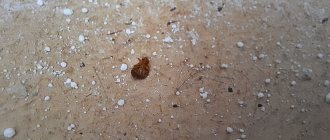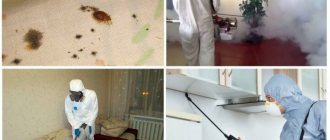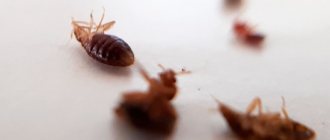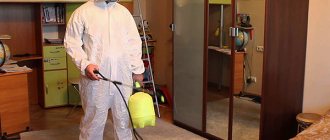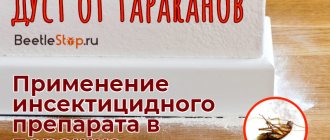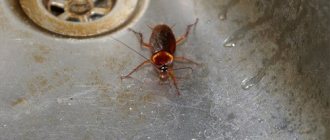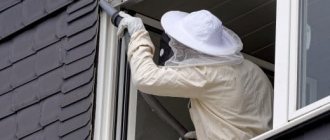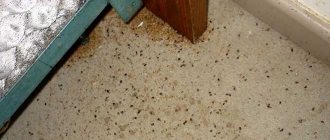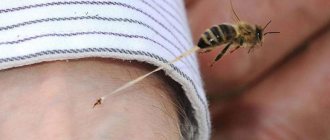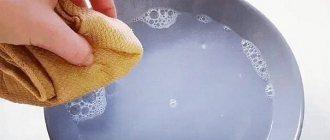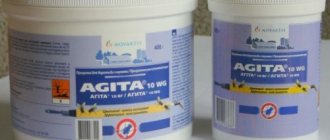(1 ratings, average: 5,00 out of 5)
Cleaning an apartment after disinfestation is as important a stage in removing insects as chemical treatment. Although complete wet cleaning is not carried out immediately after treating the room with hot fog, you can start cleaning immediately after the initial ventilation.
You can take care of the general cleaning yourself, or use the cleaning service after disinfestation. The Moscow city disinfection service "Des Eco-Mos" performs professional cleaning in an apartment or building after:
- disinfection;
- disinfestation;
- deratization and other disinfection measures.
Cleaning the apartment after disinsection of cockroaches, bedbugs or other harmful insects is of particular importance. Chitin bodies, larvae and eggs of pests must be removed from surfaces to avoid re-infection.
The cleaning service "Des Eco-Mos" specializes in cleaning after disinfection procedures. Our employees will not just clean the premises until they shine, but will ensure that the effect of the insecticide lasts as long as possible - without danger to people and pets.
What precedes cleaning
After spraying the drug, the room was closed for several hours. The first thing after a person enters the apartment is to open all the windows as much as possible or set them for ventilation (depending on the time of year). It is advisable to provide a draft so that chemical residues and smells disappear. In summer, ventilate for 2 hours or more, in winter – 45-60 minutes. These are necessary precautions. Modern products have virtually no odor, do not leave streaks or stains on walls, upholstered furniture, or household items.
You cannot carry out general cleaning including washing walls, all pieces of furniture, and hard-to-reach places. Medicines for cockroaches, bedbugs, and ants have a prolonged effect. This is designed to kill any insects that were not killed immediately after treatment. Over time, adult individuals crawl out of their shelters in search of water and food, come into contact with the remains of the poison on the surface and gradually die out. The residual activity of the drugs is at least 3 weeks. This action prevents insects from recolonizing, migrating, and reproducing.
After thorough ventilation, children, the elderly, people with chronic heart and lung diseases, and pets can enter the apartment. If insecticide particles remain in the air, their concentration is minimal and does not affect human well-being. The solution dries on surfaces, does not penetrate the bloodstream upon contact with skin, and does not pose a health hazard.
How to properly ventilate a room
This is an important step that cannot be ignored. You should open the windows and doors wide open and remove the damper from the ventilation. It is advisable to wait outside or in the entrance.
Airing takes at least an hour. Ideally, you need to create a draft, especially in the warm season. If the treatment was carried out in the summer, then ventilation should be for at least three hours.
After this, household members and their pets are allowed to return to the apartment. Staying indoors is safe for everyone, including allergy sufferers and children. While the apartment was “standing”, the insecticide settled and dried. In this form, it is not at all toxic to humans, but remains fatal to bedbugs.
Basic rules for surface cleaning
If possible, keep wet cleaning after disinsection to a minimum. Floor coverings (parquet, laminate, linoleum, tiles) can be vacuumed and swept. If you need to wash the floor, wipe the central part of the room. Do not wipe the perimeter of the room along the baseboard with a damp cloth (no closer than 10-15 cm to the wall). It is unacceptable to wash the baseboards themselves. The longer the insecticide lasts, the more effective the treatment is. One time will be enough without repeated disinfestation. Do not touch the floor under the closet, sofa, chairs, bed.
Items in the house that need to be wiped with warm soapy water and clean water (in direct contact with humans):
- the surface of the dining table, chairs, stools, bedside tables, open shelves, niches, window sills;
- plumbing – taps, sinks, bathtub, toilet, cistern;
- handles on doors, cabinets, windows.
How to prepare a solution for wet cleaning after treating bedbugs and cockroaches: baking soda (50 g), laundry soap (30 g) per bucket of water (10 l).
It is permissible to carry out wet cleaning in the children's room, in those places where the child plays or where he can climb. If there are indoor plants left in the apartment during treatment, they need to be washed in the shower so that the water does not drain into the ground.
Collect defeated insects
You will need:
- Disposable gloves
- Shoe covers
- Scoop and brush
- Garbage bag
You will find insects on the floor and open surfaces. You need to get rid of them like regular garbage. Take them out to the trash container immediately after cleaning. Check all easily accessible places where you saw them or were suggested by our specialists. We'll deal with hard-to-reach places a little later. It is better not to use a vacuum cleaner or similar equipment so that the remnants of what is being cleaned do not remain in the device.
The importance of cleaning the kitchen
The effectiveness of the entire pest control operation depends on proper cleaning of the kitchen, the main breeding ground for cockroaches. This room is treated especially carefully, if necessary with a solution of higher concentration. To ensure that your food is safe to eat, you need to properly remove any remaining chemicals.
Before pickling, all food items are removed from the kitchen and dining room. If by chance there are open or closed packages left in the cabinets, they are not suitable for consumption. Such products are collected in plastic bags, tightly sealed and thrown into the trash.
To avoid future poisoning, cleaning the kitchen involves more than just wiping down work surfaces. The interior walls and shelves of cabinets, bedside tables, and handles of household appliances (refrigerator, microwave oven) must be washed. Wipe the inner chamber of the oven and induction cooker panels. All dishes are washed in the dishwasher or by hand in the sink. After the cabinets have dried, you can put the food in its place.
What not to touch:
- skirting boards, radiators, radiators;
- tiled walls, tiles;
- the upper part of the refrigerator body, wall cabinets;
- window frame, glass taller than a person, cornices;
- hood, gas boiler, water heater (boiler);
- sockets, household appliance cables, adapters;
- water supply units (pipes, sewerage);
- waste collection place (tank, bucket);
- door frame, lighting fixtures.
Bring back the comfort
Now it’s time to put everything in its place: wash the dishes, wipe down small household appliances and decorative items, hang up clean curtains.
The fight against insects is over and you win!
How to prevent re-infection
Cleanliness in your premises and on the territory of your neighbors is the key to the absence of harmful insects. Insects can be brought indoors on clothing, but the likelihood of this is negligible.
If you did everything according to our instructions and the insects are annoying again, then we can conclude that they came to you from outside. Talk to your neighbors, show them by your example that getting rid of insects is simple, inexpensive, safe and fast.
offers a wide range of services for sanitary treatment of premises, vehicles and equipment. We have modern equipment and strict adherence to processing technologies. By contacting us, you can always be sure of the high quality of disinfestation, disinfection, deratization, site protection, ozonation, removal of mold, unpleasant odors and demercurization.
What to do with upholstered furniture
One of the first questions clients ask is whether the furniture will remain usable after disinfestation. The main concerns are stains on the fabric and the negative impact of the ingrained chemical on the body. People express concerns that inhaling toxic fumes will cause headaches, dizziness, insomnia, breathing problems, and allergic reactions.
Such thinking is misleading. The production of drugs is strictly regulated by international standards on the use of hazardous substances. This guarantees the safety of the products used to remove insects from the home.
During the first 24 hours, with poor ventilation, solution particles remain in the air. Moreover, their concentration is negligible and not dangerous to humans. The aerosol deposited on the fabric dries quickly. Upon contact with skin, it is absolutely harmless, but remains active against bedbugs.
The product is not released back from the fabric. A person sleeping on a treated sofa or bed does not inhale insecticide vapors, while being reliably protected from blood-sucking insects. Upon contact with the drug, adult individuals become infected and die.
Dry cleaning is not necessary for the upholstery of a sofa or mattress. Before spraying the emulsion, furniture can be covered with covers, blankets or sheets. After processing, wash them in a machine. Before going to bed at night, make the bed with clean linen. These rules apply to cribs.
Give the drugs time to work
From 1 to 3 hours, or better - 12
Most insects will be killed during treatment. But it is impossible to process absolutely all individuals. For example, when treating against bedbugs or cockroaches, it is important to wait time, allowing the insects to get out of hard-to-reach places onto the treated surfaces. We recommend waiting at least 1-3 hours, but the best option is to leave the room for 12 hours to ensure maximum effectiveness.
Cleaning clothes and children's toys
To simplify cleaning after disinfection against cockroaches, put the clothes in a closet before staining. This way the pesticide won't get on it. Wooden furniture in the bedroom and dressing room is processed extremely rarely, in the presence of massive populations of insects and larvae.
If the clothes were in an open space, they are washed in a machine or under running water. Fabric backpacks and bags are washable. Leather items can be wiped with a damp cloth, but you don’t have to touch them at all.
Apartment cleaning measures include disinfecting toys. Plastic products may react with chemical agents and are difficult to clean. Also, bedbugs and cockroaches do not live in them. Therefore, before disinfestation, such toys are packed in bags and left untouched. Soft toys are washed in a washing machine and dried in the fresh air.
When did the poisoning happen?
The risk of poisoning from chemicals designed for residential use is minimal. Theoretically, this cannot be ruled out. The risk group includes elderly people with severe chronic pathologies of the kidneys, heart, immune system, and metabolic disorders. The triggering factor is insufficient ventilation of the apartment and failure to follow cleaning recommendations.
Symptoms of poisoning from inhalation of insecticide:
- headaches, dizziness;
- general weakness;
- nausea, bitterness in the mouth;
- sore throat, dry suffocating cough;
- irritation, redness of the mucous membranes of the nasopharynx and eyes;
- runny nose, watery eyes, drooling.
If one or more signs occur, you need to leave the room and go outside. Within 15-20 minutes the condition should improve. If signs of poisoning increase, consult a doctor. If you experience shortness of breath or difficulty breathing, immediately call an ambulance.
Small pets - rodents (hamsters, chinchillas, house mice, rats), amphibians (turtles, chameleons) can be sensitive to chemicals. After disinsection, these animals are brought into the house in cages or terrariums and are not released. They can be picked up, but not released onto the floor, only after general cleaning (no earlier than 3-4 weeks).
Insecticides are not dangerous for large animals, dogs, cats, rabbits. Even if an animal licks a little of the dried drug, this will not affect its health. For a cat to get poisoned, it needs to lick 4-5 m2 of the treated surface, which is actually impossible.
Safety regulations
- When processing apartments, it is strictly forbidden to be present without personal protective equipment.
- Treated areas must not be used until they are cleaned.
- People suffering from various allergies should not enter the treated premises until they are fully ventilated and cleaned.
- Smoking and eating are prohibited in treated areas until they are cleaned.
- If insecticides get into the respiratory tract, rinse your throat with water to avoid chemical burns and absorption of the drug.
- If drugs get into your eyes, rinse them thoroughly with water.
Advantages of professional cleaning after disinfestation
If you doubt that you can handle the cleaning yourself after treatment for cockroaches, order a cleaning service from a company that carries out pest control.
Advantages of comprehensive service from professionals:
- knowledge of the rules for cleaning after treatment with insecticides, which guarantees safety;
- compliance with safety precautions when working with chemicals, which prevents poisoning among residents;
- availability of the necessary personal protective equipment, you do not have to additionally buy rubber gloves, detergents, rags;
- quickly bringing the apartment into a habitable condition, which saves your time;
- modern cleaning technologies, efficiency, quality;
- control system, guarantee for work performed.
If necessary, you can order additional services - eliminating unpleasant odors, cleaning surfaces, tiles from limescale, fungus, rust, water stone. For this purpose, innovative techniques and equipment are used - steam cleaner, dry fog.
